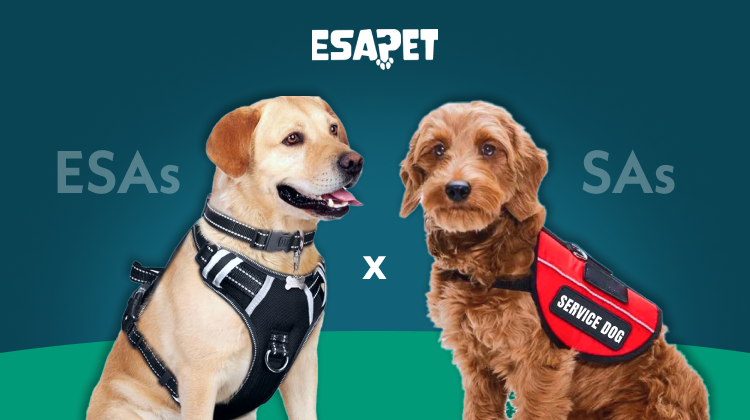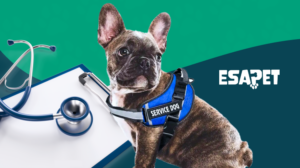ESAs vs Service Animals: Everything About Assistance Animals

Is ESA a Service Animal? Understanding the differences between ESAs and service animals is essential. Both types of animals assist individuals with disabilities. However, both serve different purposes and have distinct legal protections.
Emotional support animals (ESAs) provide comfort through their presence. They do not need special training. Service animals are trained to perform specific tasks for people with disabilities. They aid them in their daily activities.
Federal and state or local laws define the rights and protections for both ESAs and SAs. In this guide, we will explore these laws, their roles, and other details to help you understand them.
Differences Between Service Animals, ESAs, and Therapy Animals
Understanding the differences between these animals can be a bit confusing. Each has a unique role and specific regulations that apply to it. Let’s break it down.
Service Animals
Service animals undergo training to execute specific tasks that aid individuals with disabilities. These tasks can include:
- Guiding the visually impaired
- Alerting the hearing-impaired
- Pulling a wheelchair
Mostly, dogs qualify as service animals under the Americans with Disabilities Act (ADA). Due to their specialized training, the ADA grants them full access to public spaces. In specific cases, mini-horses can be trained to perform specific tasks and also qualify as SAs.
Emotional Support Animals (ESAs)
ESAs offer comfort and emotional support to individuals with mental or emotional conditions. Unlike service animals, they do not need specific training. ESAs provide emotional support for mental health disabilities, such as:
ESAs don’t get the same public access rights as service animals. However, they often receive housing allowances under the Fair Housing Act (FHA).
Therapy Animals
Therapy animals offer comfort and support by visiting hospitals, schools, and nursing homes. These animals cater to a diverse range of individuals. Therapy animals provide comfort for disabilities like:
- Anxiety
- Depression
- PTSD
- Chronic Illnesses
- Developmental Disorders
They are not trained to assist one specific individual but can enhance the well-being of many. Therapy dogs do not have the same legal protections as service animals or ESAs. A therapy animal does not have special access to public places.
Legal Protection and Definition of Emotional Support Animals and Service Animals
It is important to understand the legal protections and definitions of these animals. Both provide essential support to individuals with disabilities. However, both have different protections. Here, we explore these distinctions and the legal frameworks governing companion animals.
Differences Between Service Animals and ESAs Under ADA
The Americans with Disabilities Act (ADA) distinguishes between service animals and ESAs. Service animals get training to perform specific tasks for people with disabilities. This special training sets service animals apart from ESAs.
ESAs provide comfort to people with mental or emotional issues through their presence. However, they are not trained to do specific tasks like service animals. Due to this, ESAs do not have the same rights to access public places under the ADA.
Service animals can go with their owners to most public places. ESAs do not have this access under the ADA. But, ESAs do have some rights under other laws. For example, they can live in housing with “no pets” policies.
ADA Definitions of Service Animals
Under the ADA, a service animal is a dog that has been individually trained to do work or perform tasks for an individual with a disability.
This definition is strict, ensuring that only dogs (and, in some cases, miniature horses) that have received specialized training are considered service animals.
The tasks performed by these service animals must be directly related to the person’s disability. For instance, a dog trained to guide a blind person or alert a deaf person qualifies as a service animal. The ADA’s clear definition helps provide consistent legal protections and obligations.
Service Animals Tasks
Service animals are trained to perform a wide range of tasks. These tasks assist their handlers in daily life. Examples of these tasks include:
 Guiding the visually impaired
Guiding the visually impaired Alerting the hearing-impaired
Alerting the hearing-impaired Pulling wheelchairs
Pulling wheelchairs Retrieving items
Retrieving items Alerting to oncoming seizures
Alerting to oncoming seizuresThe specialized training of service animals allows them to mitigate specific disabilities. They help ensure their handlers can maintain greater independence and safety.
Types of Service Animals
Service animals come in various types, each individually trained to assist with specific disabilities. These animals are crucial for enhancing the independence and safety of individuals. Below, we outline the primary types of service animals and their unique roles.
- Guide Dogs for Visual Impairments: They assist individuals who are blind or have impairments. They help navigate obstacles and ensure their handlers can move safely.
- Hearing or Signal Dogs for Auditory Disabilities: These dogs alert deaf individuals. They can notify their handler of doorbells, alarms, or approaching vehicles.
- Psychiatric Service Dogs for Mental Health Conditions: Psychiatric service animals assist individuals with mental conditions. Psychiatric service animals help in interrupting harmful behaviors and providing DPT.
- Sensory Signal Dogs (SSigDOG) for Autism: SSigDOGs help individuals with autism. They do this by providing sensory support and reducing anxiety. They can interrupt self-harming behaviors and guide their handlers through crowded spaces.
- Seizure Response Dogs for Seizure Disorders: These dogs assist individuals with seizure disorders. They can detect the onset of a seizure, help keep the person safe during the episode, and retrieve medication or alert others to the situation.
Training and Certification Requirements
Training a service animal involves teaching it specific tasks to those with disabilities. Depending on the tasks needed, this training can take several months to years. Service animals must stay focused, calm, and responsive in different environments.
Professional training and owner training are the two ways to train service dogs. Professional trainers have experience and resources, which often lead to better success. Owner training allows for a more personalized approach but requires a lot of time and effort.
In the U.S., certification and registration of service animals are not required by federal law. However, some states have their own rules. Documentation can be useful if there are questions about the animal’s status.
Service animals in training may have different legal rights than fully trained ones, so checking local laws is important.
Responsibilities of ESAs and SA Handlers
Proper care and supervision of ESAs and service animals are critical. It helps maintain their well-being and ensure they can perform their roles. Handlers must be dedicated to the health and training of their animals, ensuring they can provide the necessary support.
Care and Supervision Requirements
Handlers are responsible for the daily care of their animals. It includes feeding, grooming, and providing regular exercise. Ensuring that the animal is healthy and well-maintained is important for its ability to perform its tasks.
This involves regular veterinary check-ups, proper diet, and attention to any medical needs. Handlers must also ensure that the animal’s training is consistently reinforced.
Behavior and Control Standards
Service and emotional support animals must exhibit good behavior in public settings. This includes being under the handler’s control at all times. This is possible through the use of a leash unless the handler’s disability prevents this.
The animal must not be aggressive, disruptive, or pose a threat to others. Handlers need to work on their animal’s behavior continuously. They should address any issues and seek professional help if necessary.
Vaccination and Health Requirements
Maintaining up-to-date vaccinations is a critical responsibility for handlers. This ensures the health of the service or ESA and protects public health. Animals should be vaccinated against common diseases. They need to be on preventative treatments for parasites.
Remember
Regular veterinary visits are essential. They help track the animal’s health and address any issues that arise.
Ensuring Public Safety and Compliance
Handlers must ensure their animals comply with all applicable laws and regulations. This includes those related to public safety. This involves understanding and respecting access rights and restrictions in different environments.
Handlers should be ready to present any necessary documentation to verify their animal’s status. They should be aware of their rights and responsibilities under the relevant laws.
Rights of Handlers in Public Spaces
It is important to understand the rights of handlers with SAs and ESAs in public spaces. Various laws and regulations protect these rights. They outline the obligations of public establishments to provide access and prevent discrimination.
Access to Public Facilities and Accommodations
Under the ADA, handlers of service animals have the right to access public facilities. This includes stores, hospitals, and public transportation. Service animals can go with their handlers in all areas where the public is normally permitted.
Emotional support animals do not enjoy the same broad public access rights as service animals. ESAs are often permitted in housing under the Fair Housing Act (FHA). However, they do not have the same legal entitlement to enter public spaces.
Specific Rules for Restaurants, Hotels, and Other Venues
Restaurants, hotels, and other venues must adhere to ADA regulations on service animals and ESAs. This means they cannot refuse entry to a service animal. A service animal can go with its handler to any area of a restaurant that is open to the public.
The rules can be more restrictive for emotional support animals (ESAs). They are generally not allowed in food establishments or other public venues that prohibit pets. However, some businesses may choose to accommodate them on a case-by-case basis.
Non-Discrimination Policies
These policies protect handlers from being unfairly treated due to their reliance on service animals. Under the ADA, businesses cannot discriminate against individuals with service animals. They cannot deny services, segregate, or treat these individuals less favorably.
For emotional support animals, there are non-discrimination policies under the FHA. It helps ensure that individuals are not unfairly denied accomodations with their ESAs. These policies recognize the importance of ESAs in providing support and stability to their handlers.
Requirements for Staff Interactions and Questioning
Staff at public establishments have limits on what they can ask about service animals. They are only allowed to ask if the animal is due to a disability and what tasks the animal performs. They cannot ask for documentation or demand the animal demonstrate its tasks.
For emotional support animals, staff interactions can vary depending on the situation. Landlords may request documentation from a provider verifying the need for the ESA.
Employment Rights for a Service Animal or Emotional Support Animal Handler
Employment rights for handlers ensure individuals can perform their job duties. These rights help handlers receive the necessary support. Various laws protect these rights. These laws provide guidelines for employers and outline the required accommodations.
Service Animals and ESAs in the Workplace
Under the ADA, service animals can enter the workplace as reasonable accommodations. Employers must allow these animals if they help the employee perform job functions. This includes guiding, alerting to sounds, or providing other task-specific support.
The presence of a service animal can be crucial for the employee’s productivity and safety at work. Emotional support animals in the workplace are not as straightforward. The ADA does not mandate workplace accommodations for ESAs.
However, some employers may choose to allow them as part of a broader commitment to employee well-being. Employers must consider the benefits and challenges posed by an ESA in the workplace.
Employer Responsibilities and Documentation
Employers have a responsibility to provide reasonable accommodations for employees with disabilities. This can include allowing service animals. They can request documentation to verify the need for the service animal.
Employers should work with the employee to determine the best way to accommodate the service animal. Employers may request documentation such as ESA Letters from a healthcare provider outlining the need for ESAs.
This documentation should explain how the ESA helps manage the employee’s condition. Open communication and collaboration are key to successful integration.
See If You Qualify for an ESA Letter
Trial Periods and Reasonable Accommodations
Employers can implement trial periods to test the impact of a service animal or ESA in the workplace. This period allows both parties to assess the animal within the work environment. It also provides an opportunity to address any potential issues and make necessary adjustments.
Reasonable accommodations might include designated areas for the animal to rest. They also include breaks for the handler to attend to the animal’s needs. Additionally, modifications to the employee’s work schedule may be necessary.
Employers must ensure that these accommodations do not impose an undue hardship on the business.
Handling Workplace Disruptions and Undue Hardship
If the animal causes disruptions, employers need to address it while considering the handler’s rights. This can involve re-evaluating the accommodation or exploring alternative solutions.
The goal is to find a balance that supports the employee without affecting the environment. Employers must also consider the concept of undue hardship. It refers to significant difficulty or expense incurred by providing accommodations.
If accommodating the animal imposes an undue hardship, the employer must find an alternative solution. The employer should work with the employee to ensure their needs are still supported. This solution should not cause excessive strain on the business.
Housing Rights for ESAs and Service Animals Under the FHA
Understanding housing rights for ESAs and SAs is crucial for those who rely on these animals. The FHA ensures people can live with their animals, even in places that don’t usually allow pets. This law provides protections and requires reasonable accommodations.
Under the FHA, landlords must make reasonable accommodations for both service animals and ESAs. They cannot deny housing or charge extra fees for tenants with these animals. Tenants must provide the necessary documentation to receive these accommodations.
Landlords must change their policies to allow ESAs and service animals. This includes waiving pet fees and deposits. They must talk with tenants to know their needs and ensure the accommodations are fair.
To get housing accommodations, tenants need to provide proof of a service animal or ESA. This usually means a letter from a provider stating the need for the animal.
ESAs are Exempt from Housing Pet Fees
According to the FHA, Emotional Support Animals and Service Dogs are exempt from any housing pet fees, deposits or pet rents.
Dealing with the Overlapping Protections of ADA and FHA
When it comes to service animals, both the ADA and the FHA offer protections. Here’s a simple breakdown of how these laws overlap and what you need to know:
The ADA covers public areas like lobbies and community rooms for service animals. FHA ensures that you can live with your service animal or ESA in your apartment without extra fees.
The same law allows service animals in classrooms, libraries, and other public campus areas. FHA ensures service animals and ESAs can live in dorms without extra charges. This covers both academic and residential spaces.
Under the ADA, service animals do not need documentation in public areas. Under the FHA, providers may need a letter from a licensed mental health professional. This letter should state the need for the animal. This is for housing accommodations.
If denied access, you can file complaints with:
- HUD: For Fair Housing Act (FHA) issues related to housing.
- DOJ: For ADA issues related to public access.
Education Rights and Accommodations
Various laws protect these rights. These laws outline what schools need to do to accommodate students who rely on these animals. Here’s a detailed discussion:
- Service Animals in K-12 Public Schools
Under the ADA, service animals are allowed in K-12 public schools. Students with disabilities can have their SAs with them during school hours.
Schools must allow these animals in all areas where students can go. This helps ensure the student can take part in their education. The service animal helps the student get around the school with ease.
- Post-Secondary Education Policies
Colleges and universities also have policies to accommodate service animals and sometimes ESAs. These schools must provide reasonable accommodations under the ADA and the FHA.
Students with SAs can usually have their animals in classrooms, dorms, and other campus buildings.
Accommodations for ESAs involve housing. However, some schools may offer more access based on the student’s needs.
- Role of IEP and Section 504 Teams
Individualized Education Program (IEP) and Section 504 teams play a key role. They are important in planning accommodations for students with service animals.
These teams look at the student’s needs and create a plan that includes the service animal. This team effort ensures the student gets the support needed to do well in school.
- Specific Accommodations and Restrictions
Accommodations for SAs in schools might include areas for the animals to take breaks. There could also be times for the handler to care for the animal. Additionally, schools might provide training on how to act around the service animal.
Restrictions might apply in certain places where the animal could pose a risk. In these cases, schools and universities need to find other ways to support the student. They should ensure the student can still access education without limitations.
Transportation and Travel Rights
Travel rights for ESAs and SAs ensure individuals can access public transportation. Service animals can travel on buses, trains, and other transport without extra charges. However, depending on the transport provider’s policies, ESAs might face restrictions.
Under the Air Carrier Access Act (ACAA) service animals can fly in the cabin for free. However, many airlines no longer recognize ESAs as service animals. Under the Air Carrier Access Act, ESAs can travel as pets, which involves fees.
Documentation is crucial for air travel. Airlines usually need an ESA letter from a professional for ESAs stating the need for the ESA. Service animals don’t need such documentation but may need proof of training, so a PSD letter may be handy in such situations.
Special considerations for service animals in transit include the animal’s comfort and safety. Service animals should be well-behaved and able to remain calm. Bringing necessary supplies like food, water, and medications is also recommended to ensure a smooth journey.
Bring Your Dog with You. Always.
Did you know that Service Dogs have many benefits on Hotels Pet Fees, and overall traveling over normal pets? With a PSD Letter, you may bring your dog anywhere you go for free. Read our full article to know more.
Breed Restrictions and Exceptions for Emotional Support Animals and SAs
Breed restrictions can be a significant concern for handlers of assistance animals. Some laws and housing policies restrict certain breeds, often labeling them as dangerous. However, there are exemptions for service animals that protect them from these restrictions.
Breed-Specific Laws and Service Animal Exemptions
Many municipalities have breed-specific legislation (BSL). This restricts certain dog breeds deemed dangerous, such as Pit Bulls or Rottweilers.
Under the ADA, service animals are exempt from these breed restrictions. This means that service animals can enter public spaces and housing despite local breed bans.
Case-by-Case Assessments for Breed Restrictions
For emotional support animals (ESAs), dealing with breed restrictions can be harder. ESAs don’t have the same protections as service animals. However, the FHA requires housing providers to make reasonable accommodations for ESAs.
It can include waiving breed restrictions. This is often assessed on a case-by-case basis. It includes taking into account the individual needs of the handler and the specific characteristics of the animal. It means specific breeds are recommended for those looking for adopting an ESA, but there aren’t necessarily breed restrictions to qualifying for an ESA Letter.
Exclusion of a Service Dog from Public Space
Under the ADA, service dogs have broad access rights. However, there are conditions under which they can not enter public places. It can be excluded from a public space if its presence would alter the nature of the service or program provided.
For example, a dog in a sterile hospital operating room could disrupt operations. Also, if the service animal poses a direct threat to the health or safety of others, it can be excluded. This decision should be based on actual risks and not on assumptions about the animal’s breed.
Service animals must be under the control of their handlers at all times. This means they must be on a leash or harness unless the handler’s disability prevents this. If the service animal behaves out of control, the animal can be excluded from the premises.
Examples include excessive barking, jumping on people, or aggressive behavior. Handlers must ensure their service animals are well-trained and behave in public settings.
Resources and Support Systems
These resources can help you understand your rights and legal protections. They help ensure that your animal receives the proper care and recognition.
Contact Information for ADA Assistance
If you need help with your rights under the ADA, you can reach out to the ADA Information Line. They provide information and help you understand how ADA applies to your situation.
For guidance, you can contact the ADA Information Line at 800-514-0301 (Voice) or 1-833-610-1264 (TTY). The U.S. Department of Justice offers resources and the option to file complaints through its website.
National Support Organizations
Several national organizations provide support and resources for handlers of ESAs and SAs. One such organization is the National Association of the Deaf (NAD). It offers resources for dealing with accessibility and communication barriers.
Another key organization is the Fair Housing Enforcement Office. It addresses housing discrimination issues and ensures fair housing practices. These organizations can offer valuable support and advocacy services.
Guidance Documents and Technical Assistance
The ADA National Network provides comprehensive guides and FAQs about these animals. They offer detailed information on legal rights, responsibilities, and best practices for handlers.
The Hawaii Disability and Communication Access Board provides localized information. Using these resources ensures that handlers are equipped to advocate for their rights.
Legal Enforcement and Complaint Procedures
Understanding how to protect your rights as a handler is essential. Specific legal avenues and resources are available to ensure that you can address any discrimination. This section provides the steps to file complaints and pursue legal action if needed.
States Specific Regulations
Laws change everyday, everytime. These pages from ESA Pet’s website will keep you up-to-date with your local laws and regulations.
How to Fill Complaints Under ADA and FHA?
You can file ADA complaints with the U.S. Department of Justice (DOJ). You will need to provide information about the discrimination. For FHA complaints, you can file with the Department of Housing and Urban Development (HUD). Ensure you have all relevant documentation to support your case.
Steps for Pursuing Legal Action and Resolutions
If filing a complaint does not resolve the issue, you may need to pursue legal action. This can involve hiring an attorney. Mediation is another option where a third party helps both sides reach a solution. It’s important to gather all evidence to support your case.
Relevant Agencies and Contact Information
When dealing with legal procedures, it’s crucial to know the right agencies to contact. These agencies can provide guidance for handling any issues that arise. Below are some key agencies that can assist:
- Department of Justice Civil Rights Division
Location/Area: Nationwide
How it Might Help: Handles ADA complaints. It enforces disability rights in public spaces and employment.
Contact: +1-800-514-0301
- Department of Housing and Urban Development (HUD)
Location/Area: Nationwide
How it Might Help: Addresses FHA complaints related to housing discrimination. It ensures fair housing practices.
Contact: +1-800-669-9777
- National Association of the Deaf (NAD)
Location/Area: Nationwide
How it Might Help: Provides resources and support for filing complaints related to communication barriers and accessibility.
Contact: +1-301-587-1788
- Fair Housing Enforcement Office
Location/Area: Regional Offices
How it Might Help: Investigates housing discrimination complaints and helps mediate resolutions.
Contact: Varies by region
FAQs on the Differences Between ESAs and Service Animals
What Defines a Service Animal Under the ADA?
Under the ADA, a service animal is a dog trained to perform tasks for a person with a disability. These tasks must relate to the person’s disability. The tasks can include guiding, alerting, or pulling a wheelchair.
Can Emotional Support Animals Access Public Places?
No. Emotional support animals do not have the same access rights as service animals. ESAs are not allowed in public places like restaurants and stores. However, they get accommodation in housing under the Fair Housing Act.
Are Service Animals Required to Be Professionally Trained?
No. Service animals are not required to be professionally trained. Handlers can train their service animals as long as the animals perform specific tasks related to their disability.
What Questions Can Staff Legally Ask About a Service Animal?
Staff can only ask if the service animal is due to a disability and what work or task the dog performs. They cannot ask for documentation or the nature of the disability.
Can You Just Say Your Dog Is an Emotional Support Animal?
No. You need proper documentation from a licensed provider to recognize a dog as an ESA. This documentation should state the need for an ESA.
Is a PTSD Dog a Service Dog or Emotional Support?
A PTSD dog can be a service dog if trained to perform tasks that mitigate the handler’s PTSD symptoms. If it only provides comfort, it can be an emotional support animal.
ESAs vs. SAs: Differences and Similarities Summary
It is important to understand the differences between ESAs and service animals. Service animals get training to help people with disabilities by performing specific tasks. This gives them broad access rights under the Americans with Disabilities Act (ADA).
ESAs provide comfort through their presence and have limited legal protections. ESAs have protection under the Fair Housing Act (FHA) for housing. Knowing the roles and laws that apply to ESAs and SAs is essential.
Resources like ADA guidance documents and support from national organizations can help. By understanding each type of animal, we can create a supportive environment for those who rely on them. Educating ourselves and others is key to better support and advocacy.






